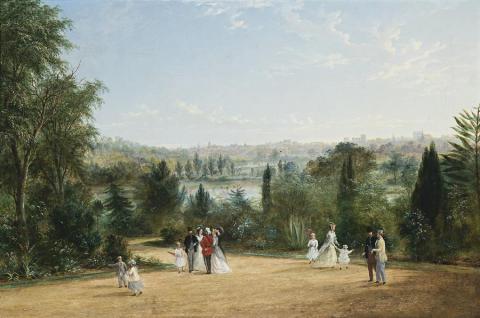VIEW OF MELBOURNE FROM THE BOTANICAL GARDENS, 1868
James Howe Carse
oil on canvas
61.0 x 92.0 cm
signed, dated, and inscribed lower right: J H Carse / Melbourne / 1868
Mrs Chartres, Melbourne
Thence by descent
Deutscher Fine Art, Melbourne
Private collection
Lauraine Diggins Fine Art, Melbourne
Private collection
Deutscher~Menzies, Sydney, 5 December 2007, lot 36
Private collection, Victoria
Hine's Art Gallery, Melbourne, August 1868
Australian Art: Colonial to Modern, Deutscher Fine Art, Perth 20 – 25 August 1986, Sydney, 5 – 13 September 1986, cat. 29 (illus. and cover detail)
Baron Ferdinand von Mueller's Botanic Gardens exercised a great appeal to the citizens of nineteenth-century Melbourne, artists and visitors. Nostalgia for the trees, flowers and other vegetation left behind in Europe must have contributed greatly to their attraction. In addition, the Gardens were a place to promenade, for bands to play, to relax and shelter in the shade of trees, while enjoying the splendid views across the River Yarra. A few years prior to James Howe Carse's painting, the Gardens were described by one nineteen-century writer as providing 'the most delightful resorts near Melbourne'.1 In their enthusiasm, De Gruchy and Leigh in the Stranger's Guide to Melbourne of 1866 went a step further, describing them as 'the most engaging lounge about Melbourne.'2 The beauty of the Gardens caught the eye of Louis Buvelot, Henry Gritten, Francois Cogné, and of course Carse. They also featured in Charles Troedel's The Melbourne Album of 1863, the tinted lithograph being by Cogne.
View of Melbourne from the Botanical Gardens 1868 must have been painted within a short time of Carse's arrival in Melbourne. The following year, it was exhibited with eight more of his paintings, mostly Victorian landscapes, in Hine's Collins Street Gallery. The sale of all nine works prompted him to settle in Australia, becoming an active figure within both the Melbourne and Sydney art communities. He was a founder member of the art academies of Victoria and New South Wales, exhibited frequently, and was awarded a first class certificate for his participation in the Philadelphia Intercolonial Exhibition. In View of Melbourne from the Botanical Gardens, Carse combines a pleasing, painterly style with a perceptive eye for detail and its accurate rendition. One's attention is drawn immediately to the elegantly attired foreground figures, of civilian and military dress, mothers and children, bonnets and parasols. The interplay between the various figures in the groups and the youthful enthusiasm of the children is one of the painting's many delights. The touch of red in the jacket provides the perfect foil for the subtle range of greens portraying with considerable dexterity the individuality of the various trees and shrubs. These give way to the waters beyond and a misty panoramic skyline of 'Marvelous Melbourne' and its spectacular architectural development - the gothic spires of churches, Parliament House, St Patrick's cathedral under construction, and the new Treasury Building. Melbourne was a gold boom city celebrated in the colonial architectural achievements of William Wardell, Joseph Reed and others. This is one of Carse's finest paintings and a rare example of the Melbourne scene.
1. llustrated Melbourne Post, 22 December 1864, p. 3
2. De Gruchy and Leigh, Stranger's Guide to Melbourne, 1866, quoted in Australian Art: Colonial to Modern Deutscher Fine Art, op. cit.
DAVID THOMAS
